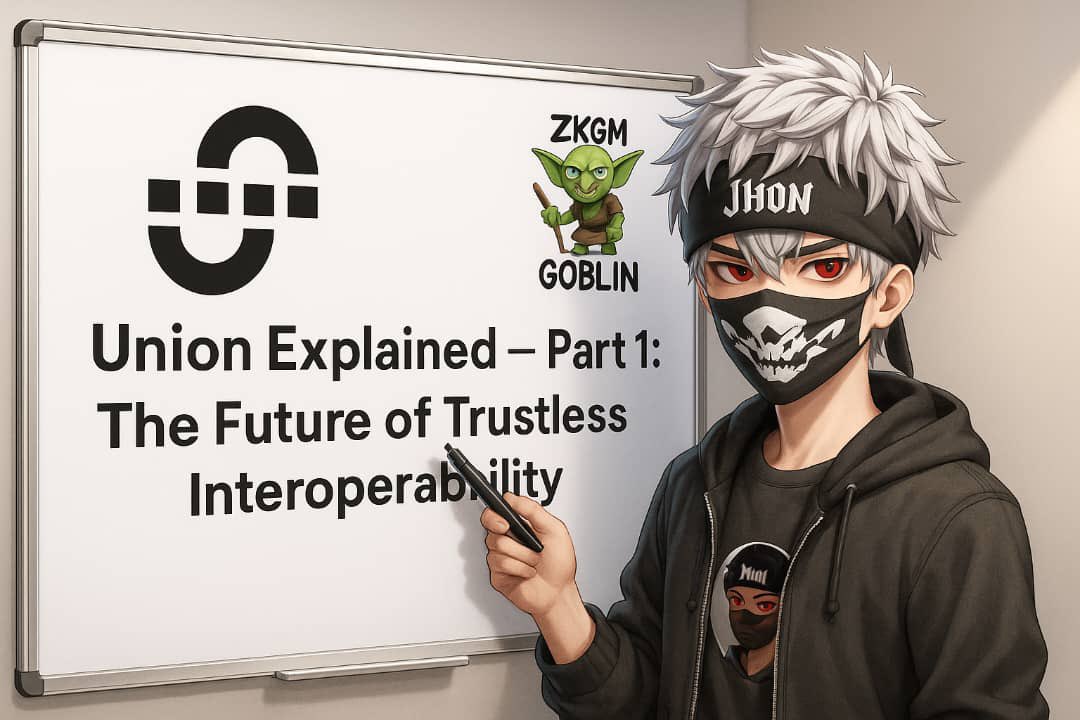[GUEST ACCESS MODE: Data is scrambled or limited to provide examples. Make requests using your API key to unlock full data. Check https://lunarcrush.ai/auth for authentication information.]
 𝐃 𝐲 𝐍𝐚𝐭𝐢𝟎𝐍 🐦🔥 [@Dy_Nati0N_](/creator/twitter/Dy_Nati0N_) on x 1628 followers
Created: 2025-07-24 07:32:21 UTC
Let’s break down how @union_build makes seamless blockchain interoperability possible.
As the blockchain ecosystem expands, one of its biggest challenges is how different chains talk to each other. Most are isolated, making it hard to share information or assets securely. Union is changing that.
What is Union?
Union is a modular interoperability protocol that lets blockchains and dApps exchange messages and assets safely. It does this using:
☛ Consensus Verification ⇢Verifying that validators on the sending chain truly agreed on the transaction.
☛ Zero-Knowledge Proofs (ZKPs) ⇢A cryptographic method that proves something is true without revealing all details. This cuts down gas fees and makes transfers cheaper and faster.
This creates a trustless, high-performance system that works across any execution environment.
What is Interoperability?
It means different blockchains can communicate and interact with one another. Union supports all environments and coding languages like Solidity, Rust, and Move to remove barriers and UX issues caused by network silos.
What is Modularity?
Modularity allows Union to be built in parts, each part can be replaced or updated without affecting the whole system. The Union stack includes:
✥ Prove: ZKPs are created using a distributed solver network.
✥ Verify: Light clients or aggregators confirm those proofs.
✥ Integrate: Developers use these tools to connect chains through protocols like IBC, ISM, or GMP.
Union Use Cases
Union enables:
❥ Message Passing: So chains and dApps can talk to each other (e.g., DEXs and lending).
❥ Asset Transfers: Move tokens or derivatives cross-chain.
❥Cross-chain NFTs: Carry NFTs across chains with metadata intact.
Union’s modular ZK framework supports unlimited use cases in a scalable Web3 world.
How Union Works
X. A blockchain connects to Union using a light client.
X. When a transaction goes from Chain A to Chain B, a ZKP is generated.
X. Chain B checks the proof through an on-chain verifier.
X. If valid, the transaction is settled and finalized.
Union verifies that Chain A’s validators agreed on the state by using ZKPs of consensus. Anyone can generate these proofs on regular hardware, and the system doesn’t rely on any centralized actors. Even if the Union’s team vanished, it would keep running permissionlessly.
End of Part X. In Part 2, we’ll explore the ZK engine behind Union; Galois, CometBLS, and more. Stay tuned.

XXX engagements

**Related Topics**
[protocol](/topic/protocol)
[coins interoperability](/topic/coins-interoperability)
[blockchain](/topic/blockchain)
[Post Link](https://x.com/Dy_Nati0N_/status/1948285106088485308)
[GUEST ACCESS MODE: Data is scrambled or limited to provide examples. Make requests using your API key to unlock full data. Check https://lunarcrush.ai/auth for authentication information.]
 𝐃 𝐲 𝐍𝐚𝐭𝐢𝟎𝐍 🐦🔥 @Dy_Nati0N_ on x 1628 followers
Created: 2025-07-24 07:32:21 UTC
𝐃 𝐲 𝐍𝐚𝐭𝐢𝟎𝐍 🐦🔥 @Dy_Nati0N_ on x 1628 followers
Created: 2025-07-24 07:32:21 UTC
Let’s break down how @union_build makes seamless blockchain interoperability possible.
As the blockchain ecosystem expands, one of its biggest challenges is how different chains talk to each other. Most are isolated, making it hard to share information or assets securely. Union is changing that.
What is Union? Union is a modular interoperability protocol that lets blockchains and dApps exchange messages and assets safely. It does this using: ☛ Consensus Verification ⇢Verifying that validators on the sending chain truly agreed on the transaction.
☛ Zero-Knowledge Proofs (ZKPs) ⇢A cryptographic method that proves something is true without revealing all details. This cuts down gas fees and makes transfers cheaper and faster.
This creates a trustless, high-performance system that works across any execution environment.
What is Interoperability? It means different blockchains can communicate and interact with one another. Union supports all environments and coding languages like Solidity, Rust, and Move to remove barriers and UX issues caused by network silos.
What is Modularity? Modularity allows Union to be built in parts, each part can be replaced or updated without affecting the whole system. The Union stack includes: ✥ Prove: ZKPs are created using a distributed solver network.
✥ Verify: Light clients or aggregators confirm those proofs.
✥ Integrate: Developers use these tools to connect chains through protocols like IBC, ISM, or GMP.
Union Use Cases Union enables: ❥ Message Passing: So chains and dApps can talk to each other (e.g., DEXs and lending).
❥ Asset Transfers: Move tokens or derivatives cross-chain.
❥Cross-chain NFTs: Carry NFTs across chains with metadata intact.
Union’s modular ZK framework supports unlimited use cases in a scalable Web3 world.
How Union Works X. A blockchain connects to Union using a light client.
X. When a transaction goes from Chain A to Chain B, a ZKP is generated.
X. Chain B checks the proof through an on-chain verifier.
X. If valid, the transaction is settled and finalized.
Union verifies that Chain A’s validators agreed on the state by using ZKPs of consensus. Anyone can generate these proofs on regular hardware, and the system doesn’t rely on any centralized actors. Even if the Union’s team vanished, it would keep running permissionlessly.
End of Part X. In Part 2, we’ll explore the ZK engine behind Union; Galois, CometBLS, and more. Stay tuned.

XXX engagements
Related Topics protocol coins interoperability blockchain